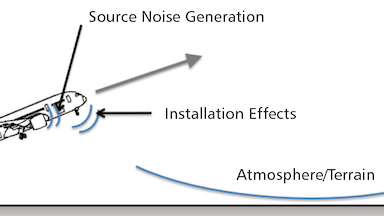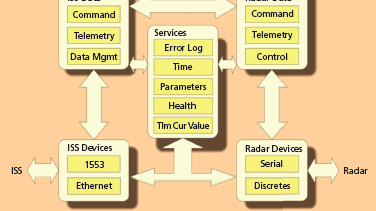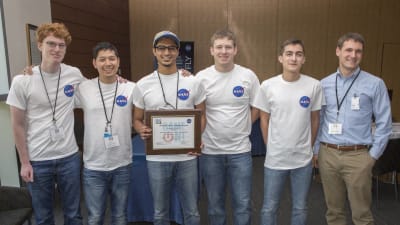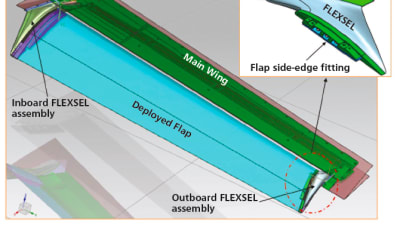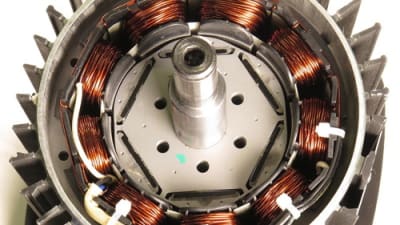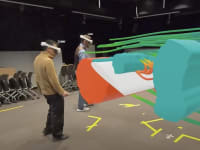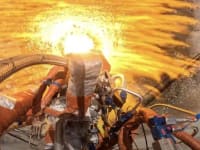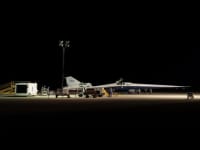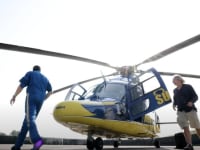Stories
48
201
61
-1
420
30
Briefs: Aerospace
Community noise has been an ongoing problem for aircraft, and is projected to be a major concern in the future due to increased air traffic. NASA’s Advanced Air Vehicles...
Briefs: Aerospace
The Integrated Minimum Drag Solution: New Wing Design Exponentially Increases Total Aircraft Efficiency
Innovators at NASA’s Armstrong Flight Research Center are experimenting with a new wing design that removes adverse yaw and dramatically increases aircraft efficiency by reducing drag. The technology has the potential to significantly increase...
Briefs: Aerospace
Terminal Airspace Configuration Scheduler (TACS)
In the current National Airspace System (NAS), there are many airports that are capacity-limited during the busiest parts of the day, and air traffic is expected to increase substantially in the future. NASA and the FAA are looking toward technologies that improve the capacity and efficiency of the...
Who's Who: Aerospace
Stevan Spremo is the project manager of COTSAT-1, or Cost Optimized Test of Spacecraft Avionics and Technologies. The ongoing development project aims to build a...
Briefs: Aerospace
System and Method for Aiding Pilot Preview, Rehearsal, Review, and Real-Time Visual Acquisition of Flight Mission Progress
NASA’s Langley Research Center has developed a synthetic 3D visualization flight display that presents flight data information in an intuitive way using 3D computer graphic capabilities. The flight crew can preview and...
Briefs: Aerospace
Innovators at NASA’s Johnson Space Center have developed a novel footpedal-operated system and device to control movement of an object in three-dimensional (3D) space. The system enables...
Briefs: Aerospace
The legacy SeaWinds scatterometer radar needed to be interfaced to the International Space Station (ISS) without any modifications. It had been designed to fly on the Adeos II spacecraft. An interface to translate...
Briefs: Aerospace
Achieving a Realistic Model of Flight Dynamics and Aeroelasticity of Flexible Aircraft
Researchers at NASA’s Armstrong Flight Research Center have developed a method that allows for the translation of frequency-domain aerodynamics from commercial code (e.g., ZAERO™ or NASTRAN®) to a time-domain formulation that can be easily understood by...
Briefs: Aerospace
AutoNav: Navigation Flight Software on a Smartphone
Today’s mobile computing platforms (phones and tablets) contain considerable computing power and are instrumented similar to spacecraft. They have cameras, accelerometers, gyros, magnetometers, GPS, and multiple radios for communication. It was postulated that a modern commercial smartphone...
News: Aerospace
On your car windshield, ice is a nuisance. But on an airplane, wind turbine, oil rig, or power line, it can be downright dangerous. And removing it with the methods that are...
INSIDER: Aerospace
NASA Selects Eight Aerospace Technology Proposals for Investment
NASA has selected eight technology proposals for investment. The ideas have the potential to transform future aerospace missions, introduce new capabilities, and significantly improve current approaches to building and operating aerospace systems.
INSIDER: Aerospace
Students from the University of Illinois at Urbana-Champaign took top honors in NASA’s first Breakthrough, Innovative and Game-changing (BIG) Idea Challenge.The challenge: To...
News: Aerospace
NASA and its partners are validating and advancing technologies that will assist the FAA as they develop the regulations to allow integration of unmanned aircraft into the National Airspace...
Briefs: Aerospace
Airframe noise, produced by unsteady flow around aircraft structures, is an important source of aircraft noise during approach and landing. Sound radiating from the undercarriage is a major contributor...
Briefs: Aerospace
Autonomous Leading-Edge Slat Device for Reduction of Aeroacoustic Noise Associated with Aircraft Wings
Conventional transport aircraft wing design is driven mainly by cruise efficiency, i.e., adequate lift is generated at high speed for level flight with minimal drag. Conventional high-lift systems (leading edge slats and trailing edge flaps) were...
Briefs: Aerospace
StormGen Weather Editor
Experiments that take into account the impact of convective weather on airspace operations, future concepts, and flight deck tools require a source of weather data that is readily available, of predictable quality, and tailorable to experimental objectives. Real-world weather data is sparse, highly random, and disorganized....
Briefs: Aerospace
Pair-wise Trajectory Management (PTM) Airborne Human Machine Interface (HMI) Display Design
Pair-wise Trajectory Management (PTM) is a concept that utilizes airborne and ground-based capabilities to enable airborne spacing operations in oceanic regions. The goal of PTM is to use enhanced surveillance, along with airborne tools, to manage the...
Briefs: Aerospace
Airframe noise is a significant part of the overall noise of typical transport aircraft during the approach and landing phases of flight. Airframe noise reduction is...
Briefs: Aerospace
Aircraft Engine Exhaust Nozzle System for Jet Noise Reduction
Conventional aircraft typically include propulsion engines that are under the wing or tail surfaces. Each propulsion engine system includes an engine housed in a nacelle with an inlet and a nozzle system. Primary component noise sources from the engine system include the noise associated...
Briefs: Aerospace
Rotorcraft Noise Model (RNM)
The Rotorcraft Noise Model (RNM) is a suite of computer models that predicts far-field noise for single or multiple flight vehicle operations. RNM calculates the effects of sound propagation over varying ground terrain for acoustic sources using geometrical theory of diffraction algorithms, and through a horizontally...
INSIDER: Electronics & Computers
Researchers have developed the CAROS (Climbing Aerial RObot System) wall-climbing robot with higher mobility than existing wall-climbing robots because it can fly. It also can restore its pose...
News: Aerospace
A team of Northwestern researchers has created a new way to print three-dimensional metallic objects using rust and metal powders.
Articles: Aerospace
“The sky could become increasingly crowded as personal and commercial uses of unmanned aircraft systems (UAS) become more popular,” said Parimal Kopardekar, manager of NASA’s Safe Autonomous Systems...
INSIDER: Motion Control
The automotive and aeronautic industries often rely on shape optimization, an approach that uses modeling to create a framework for making devices as smooth and efficient as possible....
Briefs: Aerospace
Station/Orbiter Multibody Berthing/Docking Analysis Tool (SOMBAT)
The main objective of this work was to develop a high-fidelity, nonlinear simulation of complex flexible structures with active control systems. A multibody system can consist of several flexible articulating components. The system can also have multiple control systems. The main...
Briefs: Aerospace
Flight Deck Predicted Weather Display and Decision Support Interface
This innovation is a suite of three methods built into a prototype flight deck navigation display interface that supports the display of predicted weather and weather avoidance decision-making. Currently, the interface uses weather objects derived from various convective weather...
Briefs: Aerospace
Timed Injection of Simulation Data via Redundant Network Ports in Time Triggered Ethernet (TTE) Systems
Vehicle-scale integration and test requires closed-loop simulation using full-scale avionics systems or even entire vehicles. Incorporation of simulation data into real systems is problematic because real system sensors report the real laboratory...
Briefs: Aerospace
Method of Performing Computational Aeroelastic Analyses
When designing aerodynamic structures, it is important to understand if, and under what aerodynamic conditions, the structure will be stable and unstable. This is especially true if a structure is inherently flexible, such as a wing, where unstable response leads to oscillations of the...
Briefs: Aerospace
Graphical Acoustic Liner Design and Analysis Tool
The Interactive Liner Impedance Analysis and Design (ILIAD) tool is a software package used to design the composite surface impedance of an acoustic liner using resonant channels. ILIAD’s graphical user interface allows the acoustic channel geometry to be drawn in the liner volume while the...
Top Stories
Blog: Manufacturing & Prototyping
2025 Holiday Gift Guide for Engineers: Tech, Tools, and Gadgets
Blog: Power
Using Street Lamps as EV Chargers
INSIDER: Semiconductors & ICs
Scientists Create Superconducting Semiconductor Material
Blog: Materials
This Paint Can Cool Buildings Without Energy Input
Blog: Software
Quiz: Power
Webcasts
 Upcoming Webinars: AR/AI
Upcoming Webinars: AR/AI
The Real Impact of AR and AI in the Industrial Equipment Industry
 Upcoming Webinars: Motion Control
Upcoming Webinars: Motion Control
Next-Generation Linear and Rotary Stages: When Ultra Precision...
 Podcasts: Manufacturing & Prototyping
Podcasts: Manufacturing & Prototyping
SAE Automotive Engineering Podcast: Additive Manufacturing
 Podcasts: Defense
Podcasts: Defense
A New Approach to Manufacturing Machine Connectivity for the Air Force
 On-Demand Webinars: Manufacturing & Prototyping
On-Demand Webinars: Manufacturing & Prototyping
Streamlining Manufacturing with Integrated Digital Planning and Simulation


